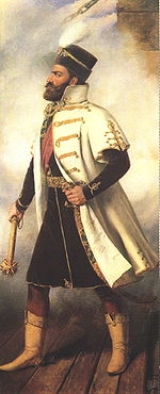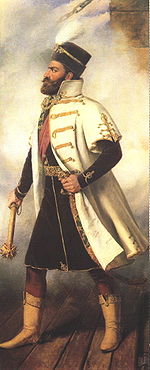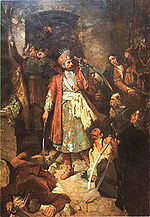
Nikola Šubic Zrinski
Encyclopedia
Nikola Šubić Zrinski
Nikola Šubić Zrinski (nǐkɔla ʃûbitɕ zrîːɲskiː or Miklós Zrínyi (ˈmikloːʃ ˈzriːɲi) (Zrin
, 1508 – Szigetvár
, September 7, 1566), was a Croatian
nobleman and general in service of Habsburg Monarchy
, ban
of Croatia
from 1542 to 1556, and member of the Zrinski
noble family. He was known across Europe
for his involvement with the Battle of Szigetvár
and is today seen as a hero by both Hungarians and Croatians.
 Nikola was born in 1508 as the son of Nikola III Zrinski
Nikola was born in 1508 as the son of Nikola III Zrinski
and Jelena Karlović (sister of future Croatian ban Ivan Karlović
) He distinguished himself at the siege of Vienna
in 1529, and in 1542 saved the imperial army from defeat before Pest by intervening with 400 Croats
, for which service he was appointed ban
of Croatia
. In 1542 he routed an Ottoman
force at the Battle of Somlyo.
In 1543 he married Catherine (Katarina) Frankopan
, a sister of Count Stjepan Frankopan Ozaljski ("Stephen Frankopan of Ozalj" in English), who placed the whole of her vast estates at his disposal. She bore him many children, among which was his successor Juraj IV Zrinski
. The king Ferdinand I
gave him large possessions in Hungary
and Croatia
, and henceforth the Zrinskis–Zrínyis became as much Magyar as Croatian magnates.
In 1556 Zrinski won a series of victories over the Ottoman
s, culminating in the battle of Babócsa. The Croats, however, overwhelmed their ban with reproaches for neglecting them to fight for the Magyars, and the emperor simultaneously deprived him of the captaincy of Upper Croatia and sent 10,000 men to aid the Croats, while the Magyars were left without any help, whereupon Zrinski resigned the banship (1561). In 1563, on the coronation of the Emperor Maximilian
as king of Hungary, Zrinski attended the ceremony at the head of 3000 Croatian and Magyar mounted noblemen, in the vain hope of obtaining the dignity of palatine, vacant by the death of Tamás Nádasdy. Shortly after marrying (in 1564) his second wife, Eva of Rožmberk (Rosenberg), a great Bohemia
n heiress, he hastened southwards to defend the frontier, and defeated the Ottomans at Szeged
.
 In 1566, from August 5 to September 7, his small force (2,300 soldiers) heroically defended the little fortress of Szigetvár
In 1566, from August 5 to September 7, his small force (2,300 soldiers) heroically defended the little fortress of Szigetvár
against the whole Ottoman host (102,000 soldiers), led by Suleiman the Magnificent
in person. The Battle of Szigetvár
ended with Zrinski perishing with every member of the garrison in a last desperate sortie. Suleiman had died shortly previous.
(Viceroy) and Croatian/Hungarian poet Nikola Zrinski, as well as his younger brother Petar Zrinski
. The former wrote the Hungarian
epic poem
, the Peril of Sziget
, of which Zrinski is the hero, which has assured Zrinski's place in Hungarian culture. The epic remains in print today and is considered one of the landmarks of Hungarian literature. Nikola Šubić Zrinski is honoured both in Croatia and in Hungary as a national hero. A park in the Croatian capital Zagreb
is named Trg Nikole Šubića Zrinskog
after him. Zrinski's last battle was made the subject of a tragedy, Zrinyi: Ein Trauerspiel, by Theodor Körner
.
Nikola Šubić Zrinski (nǐkɔla ʃûbitɕ zrîːɲskiː or Miklós Zrínyi (ˈmikloːʃ ˈzriːɲi) (Zrin
Zrin Castle
Zrin Castle is a ruined castle located in the village of Zrin, south of the town of Sisak in central Croatia.-History:The castle was first mentioned in the 13th century as a fortress ruled by the Babonić clan. Later it was possessed by the members of Iločki family...
, 1508 – Szigetvár
Szigetvár
-History:The town's fortress was the setting of the Battle of Szigetvár in 1566. It was a sanjak centre at first in Budin Province , later in Kanije Province .There was already a bum in the marshland back in the Celtic and Roman times...
, September 7, 1566), was a Croatian
Croats
Croats are a South Slavic ethnic group mostly living in Croatia, Bosnia and Herzegovina and nearby countries. There are around 4 million Croats living inside Croatia and up to 4.5 million throughout the rest of the world. Responding to political, social and economic pressure, many Croats have...
nobleman and general in service of Habsburg Monarchy
Habsburg Monarchy
The Habsburg Monarchy covered the territories ruled by the junior Austrian branch of the House of Habsburg , and then by the successor House of Habsburg-Lorraine , between 1526 and 1867/1918. The Imperial capital was Vienna, except from 1583 to 1611, when it was moved to Prague...
, ban
Ban (title)
Ban was a title used in several states in central and south-eastern Europe between the 7th century and the 20th century.-Etymology:The word ban has entered the English language probably as a borrowing from South Slavic ban, meaning "lord, master; ruler". The Slavic word is probably borrowed from...
of Croatia
Croatia
Croatia , officially the Republic of Croatia , is a unitary democratic parliamentary republic in Europe at the crossroads of the Mitteleuropa, the Balkans, and the Mediterranean. Its capital and largest city is Zagreb. The country is divided into 20 counties and the city of Zagreb. Croatia covers ...
from 1542 to 1556, and member of the Zrinski
Zrinski
The Zrinski family was a Croatian noble family, influential during the period in history marked by the Ottoman wars in Europe in the Kingdom of Croatia and Hungary and in the later Austro-Hungarian Empire...
noble family. He was known across Europe
Europe
Europe is, by convention, one of the world's seven continents. Comprising the westernmost peninsula of Eurasia, Europe is generally 'divided' from Asia to its east by the watershed divides of the Ural and Caucasus Mountains, the Ural River, the Caspian and Black Seas, and the waterways connecting...
for his involvement with the Battle of Szigetvár
Battle of Szigetvár
The Siege of Szigetvár or Battle of Szigeth was a siege of the Szigeth Fortress in Baranya which blocked Suleiman's line of advance towards Vienna in 1566 AD...
and is today seen as a hero by both Hungarians and Croatians.
Biography

Nikola III Zrinski
Nikola III Zrinski , , was a Croatian nobleman, a member of the Zrinski noble family, influential in the Croato-Hungarian Kingdom.-Life:...
and Jelena Karlović (sister of future Croatian ban Ivan Karlović
Ivan Karlovic
Ivan Karlović was the Ban of Croatia from 1521 to 1524 and again from 1527 to 1531. Karlović's seat was in Medvedgrad....
) He distinguished himself at the siege of Vienna
Siege of Vienna
The Siege of Vienna in 1529 was the first attempt by the Ottoman Empire, led by Suleiman the Magnificent, to capture the city of Vienna, Austria. The siege signalled the pinnacle of the Ottoman Empire's power, the maximum extent of Ottoman expansion in central Europe, and was the result of a...
in 1529, and in 1542 saved the imperial army from defeat before Pest by intervening with 400 Croats
Croats
Croats are a South Slavic ethnic group mostly living in Croatia, Bosnia and Herzegovina and nearby countries. There are around 4 million Croats living inside Croatia and up to 4.5 million throughout the rest of the world. Responding to political, social and economic pressure, many Croats have...
, for which service he was appointed ban
Ban (title)
Ban was a title used in several states in central and south-eastern Europe between the 7th century and the 20th century.-Etymology:The word ban has entered the English language probably as a borrowing from South Slavic ban, meaning "lord, master; ruler". The Slavic word is probably borrowed from...
of Croatia
Croatia
Croatia , officially the Republic of Croatia , is a unitary democratic parliamentary republic in Europe at the crossroads of the Mitteleuropa, the Balkans, and the Mediterranean. Its capital and largest city is Zagreb. The country is divided into 20 counties and the city of Zagreb. Croatia covers ...
. In 1542 he routed an Ottoman
Ottoman Empire
The Ottoman EmpireIt was usually referred to as the "Ottoman Empire", the "Turkish Empire", the "Ottoman Caliphate" or more commonly "Turkey" by its contemporaries...
force at the Battle of Somlyo.
In 1543 he married Catherine (Katarina) Frankopan
Frankopan
The Frankopans are a Croatian noble family. Also called Frankapan, Frangepán in Hungarian, and Frangipani in Italian.The Frankopan family is the leading princely Croatian aristocratic family which dates back to the 12th Century and even earlier to Roman times...
, a sister of Count Stjepan Frankopan Ozaljski ("Stephen Frankopan of Ozalj" in English), who placed the whole of her vast estates at his disposal. She bore him many children, among which was his successor Juraj IV Zrinski
Juraj IV Zrinski
Juraj IV Zrinski , , was a Croatian count, a member of the Zrinski noble family.-Life:...
. The king Ferdinand I
Ferdinand I, Holy Roman Emperor
Ferdinand I was Holy Roman Emperor from 1558 and king of Bohemia and Hungary from 1526 until his death. Before his accession, he ruled the Austrian hereditary lands of the Habsburgs in the name of his elder brother, Charles V, Holy Roman Emperor.The key events during his reign were the contest...
gave him large possessions in Hungary
Hungary
Hungary , officially the Republic of Hungary , is a landlocked country in Central Europe. It is situated in the Carpathian Basin and is bordered by Slovakia to the north, Ukraine and Romania to the east, Serbia and Croatia to the south, Slovenia to the southwest and Austria to the west. The...
and Croatia
Croatia
Croatia , officially the Republic of Croatia , is a unitary democratic parliamentary republic in Europe at the crossroads of the Mitteleuropa, the Balkans, and the Mediterranean. Its capital and largest city is Zagreb. The country is divided into 20 counties and the city of Zagreb. Croatia covers ...
, and henceforth the Zrinskis–Zrínyis became as much Magyar as Croatian magnates.
In 1556 Zrinski won a series of victories over the Ottoman
Ottoman Empire
The Ottoman EmpireIt was usually referred to as the "Ottoman Empire", the "Turkish Empire", the "Ottoman Caliphate" or more commonly "Turkey" by its contemporaries...
s, culminating in the battle of Babócsa. The Croats, however, overwhelmed their ban with reproaches for neglecting them to fight for the Magyars, and the emperor simultaneously deprived him of the captaincy of Upper Croatia and sent 10,000 men to aid the Croats, while the Magyars were left without any help, whereupon Zrinski resigned the banship (1561). In 1563, on the coronation of the Emperor Maximilian
Maximilian II, Holy Roman Emperor
Maximilian II was king of Bohemia and king of the Romans from 1562, king of Hungary and Croatia from 1563, emperor of the Holy Roman Empire of the German Nation from 1564 until his death...
as king of Hungary, Zrinski attended the ceremony at the head of 3000 Croatian and Magyar mounted noblemen, in the vain hope of obtaining the dignity of palatine, vacant by the death of Tamás Nádasdy. Shortly after marrying (in 1564) his second wife, Eva of Rožmberk (Rosenberg), a great Bohemia
Bohemia
Bohemia is a historical region in central Europe, occupying the western two-thirds of the traditional Czech Lands. It is located in the contemporary Czech Republic with its capital in Prague...
n heiress, he hastened southwards to defend the frontier, and defeated the Ottomans at Szeged
Szeged
' is the third largest city of Hungary, the largest city and regional centre of the Southern Great Plain and the county town of Csongrád county. The University of Szeged is one of the most distinguished universities in Hungary....
.

Szigetvár
-History:The town's fortress was the setting of the Battle of Szigetvár in 1566. It was a sanjak centre at first in Budin Province , later in Kanije Province .There was already a bum in the marshland back in the Celtic and Roman times...
against the whole Ottoman host (102,000 soldiers), led by Suleiman the Magnificent
Suleiman the Magnificent
Suleiman I was the tenth and longest-reigning Sultan of the Ottoman Empire, from 1520 to his death in 1566. He is known in the West as Suleiman the Magnificent and in the East, as "The Lawgiver" , for his complete reconstruction of the Ottoman legal system...
in person. The Battle of Szigetvár
Battle of Szigetvár
The Siege of Szigetvár or Battle of Szigeth was a siege of the Szigeth Fortress in Baranya which blocked Suleiman's line of advance towards Vienna in 1566 AD...
ended with Zrinski perishing with every member of the garrison in a last desperate sortie. Suleiman had died shortly previous.
Legacy
He was the great-grandfather of Croatian BanBan (title)
Ban was a title used in several states in central and south-eastern Europe between the 7th century and the 20th century.-Etymology:The word ban has entered the English language probably as a borrowing from South Slavic ban, meaning "lord, master; ruler". The Slavic word is probably borrowed from...
(Viceroy) and Croatian/Hungarian poet Nikola Zrinski, as well as his younger brother Petar Zrinski
Petar Zrinski
Petar Zrinski was a Croatian Ban and writer. A member of the Zrinski noble family, he was noted for his role in the attempted Croatian-Hungarian rebellion of 1664-1670 which ultimately led to his execution for high treason.-Zrinski family:Petar Zrinski was born in Vrbovec, a small town near...
. The former wrote the Hungarian
Hungarian language
Hungarian is a Uralic language, part of the Ugric group. With some 14 million speakers, it is one of the most widely spoken non-Indo-European languages in Europe....
epic poem
Epic poetry
An epic is a lengthy narrative poem, ordinarily concerning a serious subject containing details of heroic deeds and events significant to a culture or nation. Oral poetry may qualify as an epic, and Albert Lord and Milman Parry have argued that classical epics were fundamentally an oral poetic form...
, the Peril of Sziget
Peril of Sziget
Szigeti veszedelem was the title of the Hungarian epic poem in fifteen parts written by Miklós Zrínyi in 1647 and published in 1651 about the final battle of his great-grandfather Miklós Zrínyi against the Ottomans in 1566.The poem recounts in epic fashion the Battle of Szigetvár, in...
, of which Zrinski is the hero, which has assured Zrinski's place in Hungarian culture. The epic remains in print today and is considered one of the landmarks of Hungarian literature. Nikola Šubić Zrinski is honoured both in Croatia and in Hungary as a national hero. A park in the Croatian capital Zagreb
Zagreb
Zagreb is the capital and the largest city of the Republic of Croatia. It is in the northwest of the country, along the Sava river, at the southern slopes of the Medvednica mountain. Zagreb lies at an elevation of approximately above sea level. According to the last official census, Zagreb's city...
is named Trg Nikole Šubića Zrinskog
Nikola Šubić Zrinski Square
Nikola Šubić Zrinski Square is a square and park in Donji Grad, the central part of Zagreb, the capital of Croatia. It is located near the central Ban Jelačić Square, halfway towards the Main Railway Station. It is a part of the so-called Green horseshoe or Lenuzzi's horseshoe , which consists of...
after him. Zrinski's last battle was made the subject of a tragedy, Zrinyi: Ein Trauerspiel, by Theodor Körner
Theodor Körner (author)
Karl Theodor Körner was a German poet and soldier. After some time in Vienna, where he wrote some light comedies and other works, he became a soldier and joined the German uprising against Napoleon...
.
See also
- U boj, u bojU boj, u boj"U boj, u boj" is a Croatian patriotic song. It was written and composed by Ivan Zajc in 1866, who later incorporated it as an aria into his opera Nikola Šubić Zrinski where it is sung by a male choir....
- The Slav EpicThe Slav EpicThe Slav Epic is a cycle of 20 large canvases painted by Czech Art Nouveau painter Alfons Mucha between 1910 and 1928. The cycle depicts the history of Czechs and other Slavic peoples. In 1928, after finishing his monumental work, Mucha bestowed the cycle to the city of Prague on condition that...
(Painting: "Defense of Sziget against the Turks by Nicholas Zrinsky")

